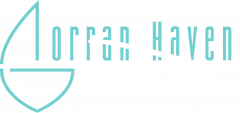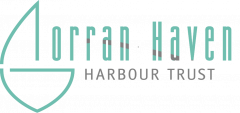Our History
Gorran Haven Harbour Trust
(Registered Charity Number 1172560)
Gorran Haven Quay
At the dawn of history there was sea. Life in Gorran Haven has always been inextricably attached to the sea. Generation after generation has worked on the sea, lived on the sea and, for some, have died in the sea. The harbour and foreshore have played a leading role in community life.
Records of a sea fishery at Gorran Haven date back to 1270 and the Taxation of 1271 (which dealt with tithes) refers to seines which was one of the earliest references to seining in the county and shows that pilchard fishing was of prime importance even then. The communities which existed around the coves and ports of Cornwall depended on the pilchard season and the harvest (or ‘hevva’) which could be reaped. If the pilchards didn’t come, then the communities would suffer severe hardship and even starvation. ‘Herring’ was the local dialect word for ‘pilchards’.
The first detailed record of the fishing community in Gorran Haven came in 1570 and 68 men were listed. At that time Mevagissey is recorded as having just 8 fishermen! It is therefore a fact that, with a looming Spanish Armada, Gorran Haven was prepared to supply as many men and boats as any other port in Cornwall. On 20th July 1588, the Armada regrouped off the Dodman Point before encountering the English fleets within sight of Gorran Haven.
In the 17th century, the quay had deteriorated to such an extent that the 12s tax, paid by the parish to Sir Henry Bodrugan for the upkeep of the harbour, was withheld. Eventually the Edgcumbes repaired the quay.
Gorran Haven is particularly vulnerable to winds having ‘east’ in their direction. It’s believed that through the centuries a total of six different quays have been built at Gorran Haven, most of which had been washed away by easterly storms.
The Union Cellar (Big Cellars) was built around 1815 and was used for curing 800 hogsheads of pilchards annually, which equated to about 160 tons.
In 1820, an Act of Parliament was obtained for ‘completing and maintaining the harbour, quay or pier’. Shareholders formed the Goran Harbour Company but a new quay would not be built for over 60 years.
With no protection from easterly winds, the local fishermen faced the backbreaking job of hauling their boats up and down the beach whenever the weather threatened. In addition, properties in the immediate vicinity of the shore risked serious damage. Records show that on the 2nd January 1867, a severe gale from the east washed away part of what was then the Ship Inn at Beach Corner and other properties also sustained serious damage. But help was to come.
The Williams family had made their fortune from mining and in 1852 they purchased the Caerhayes estate from the Trevanions. The Trevanions had benefited from the downfall of the Bodrugans who had backed Richard III at Bosworth Field in 1485. John Charles Williams built the castle that currently stands at Caerhayes. He was a kind and generous man, whose property included the land to the south of the stream running down to Gorran Haven beach. The quay and pound area belonged to the Duchy of Cornwall from whom Mr Williams bought it for the sum of £5. He then decided to build a quay for the fishermen of Gorran Haven. It was completed in 1886 at a cost of several thousand pounds.
The 1889 records show that there were 35 working boats at Gorran Haven (using sail and oars), 1 boat over 15 tons and 50 full-time working fishermen.
In 1894 the Merchant Shipping Act required fishing boats to be registered, and Fowey’s register between 1902 and 1907 records the registration of 200 boats (bearing the prefix ‘FY’ to their individual number). 70 of these boats were berthed at Mevagissey, 57 at Looe, 1 at Portloe and 43 at Gorran Haven. Most of the local first class drivers, luggers and crabbers were built by Dick Pill and his experienced team of boatbuilders who worked in their workshop at the bottom of Foxhole Lane (where The Haven Café now stands) Just two or three of the Dick Pill crabbers remain in the village.
In December 1917, the Gorran Haven Fishermen’s Co-operative Society was founded. This was one of the first 10 fishermen’s co-operatives formed in the UK. The capital for it came from the fishermen themselves who bought shares at £1 each. Most bought about twenty shares. The Co-op assumed responsibility for the maintenance of the quay and the pound. The Co-op also organised the sale of all fish, especially crabs and lobsters. These were carried in mawns from the crabbers to the packing shed at Beach Corner (where the Mermaid is today) A lorry was purchased to transport the shellfish to St Austell railway station, from where it was taken to Billingsgate Market in London. Fishing gear and clothing were also bought and sold to Co-op members at cost price.
The Pound was built by JC Williams and, following the installation of a winch, the Gorran Haven Co-operative Winch Society was formed in October 1930.
The outbreak of the Second World War in 1939 signalled the beginning of the end of Gorran Haven as a commercial fishing village. Young men were called up for the forces, leaving only the older fishermen to continue. The young men had however already begun to turn their backs on fishing as a livelihood, encouraged by their fathers who could scarcely earn a living from it.
In the 1950’s only a few full-time fishermen remained and it became abundantly clear to them that they could not keep the Co-op going. The lorry was sold, as was the lorry store and the packing shed at Beach Corner was closed. While it may have been the end of the Co-op, responsibility for the maintenance of the quay remained.
1961 was a critical year. In the spring a very severe north-east gale swept huge seas around the northern end of the quay and across the harbour pounding the deck mercilessly at the point where the quay widens. The damage done was alarming. The deck was torn off. The apron, which is the quay’s foundations), near the end of the quay was badly undermined and the quay was in danger of collapsing. The foreshore from Beach Corner to Fort was badly eroded causing danger of cliff falls. The sewage pipe at the back of the quay had its concrete covering torn off and pipe fractures caused raw sewage to spew out everywhere. Urgent action was required.
The fishermen were faced with an impossible situation. The cliff was the responsibility of the Rural District Council, as was the sewage outfall pipe, but the quay belonged to the fishermen. Their slender funds were not enough to effect the repairs desperately needed. Their Chairman Bill Hammond and Secretary Spencer Holland had contacted all possible sources of help but they were given only excuses, which amounted to refusals. The Ministry would only help if a Harbour Board existed, and there was none. The Chairman of the Parish Council, Robert Wellington, accompanied by representatives and full-time fishermen Lewis Billing and Jim Liddicoat, addressed the full Rural District Council and unsuccessfully pleaded their cause. In view of the urgency of repairs, a public meeting was called at the Institute to launch a fund to save the quay.
On 24th September 1962, local contributions had reached a total of £782. In the meantime a Harbour Board had been formed, and in consequence, the Ministry of Agriculture and Fisheries had donated £1500. By January 1964 the quay had been repaired, all bills paid and a total of £462 16s 2d remained in hand. This was deposited in Lloyds Bank “to be used when all other funds had been exhausted” and was known as the ‘Quay Fund’.
It was at this time that the few remaining fishermen needed professional help in preserving and protecting the quay. They decided to approach Hugh Park, a distinguished Q.C. who had first come to Gorran Haven as a visitor in 1946. A lifelong lover of the sea and a keen fisherman, he fell for the Haven’s charms, bought a cottage near the harbour, acquired a boat and came to visit whenever circumstances permitted. He was friendly, interested in the fishermen, their work and their affairs.
Mr Justice Park (later Sir Hugh) was a source of encouragement as he gathered and collated all the papers associated with the Co-op, the Pound and the background to the quay. He was able to establish that the fishermen owned the freehold of the quay and the Pound, together with that part of the beach between the northern end of the Pound wall and the northern end of the quay. So, in 1974, the old societies merged into the Gorran Haven Harbour and Fishermen’s Society Ltd, registered under the Industrial and Provident Societies Act 1965. The new Society was set up on a strong and sound legal basis.
In the 1990s, the Society benefited from South West Water’s ‘Clean Sweep’ programme and the installation of a pumping station and holding tank in the Pound. A solid Pound floor was installed, together with a new store and winch house. South West Water have been granted a 99 year lease at a satisfactory annual rental, to be reviewed every three years.
In 2007, the Society’s integrity came under serious threat when a developer bought two parts of the Big Cellars building. He applied for planning permission to convert these into residential accommodation. The harbour users and residents vehemently objected to this proposal. Under the pressure generated, the planning application was withdrawn and the building remains largely unchanged.
In 2017, the Society was registered as a charity and became the Gorran Haven Harbour Trust (Registered Charity No 1172560). The Trust is administered by trustees who have responsibility for managing the quay, the moorings, the Pound and a section of the Big Cellars, which continues to be a store for fishing gear and a place for making nets and crab pots. The Trust appoints and employs a part-time harbourmaster, secretary and treasurer to administer its responsibilities.
It is hoped that this summary of our harbour history will be both a reminder of our wonderful heritage and an incentive to preserve our unique facility for future generations of sea-lovers.

